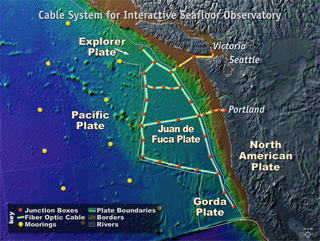Details
Researchers Gear-up to Explore the Oceans with Cabled Observatories
|
|
 It is said that we know less about the Earth's oceans than we do about the entire surface of the moon, but advances in broadband communications may finally change all that. Several major research intiatives are underway to install cabled observatories offshore the US coastline. NEPTUNE, one of the first and most ambitious programs, intends to create a 2,000 mile-long cabled observatory that wraps around the Juan de Fuca and Gorda oceanic plates off the northwest US coast. Last year, NSF awarded $3.9 million to the University of Washington, University of California, San Diego, and partner institutions to create the Laboratory for the Ocean Observatory Knowledge Integration Grid, or LOOKING project, which will design the cyberinfrastructure that is central to NEPTUNE and other observatories, such as the Monterey Accelerated Research System (MARS) run by the Monterey Bay Aquarium Research Institute (MBARI). Coordination between the various research programs at the national level will be managed and operated by the Ocean Research Interactive Observatory Networks (ORION) program. When installed these observatories will provide for the first time the essential infrastructure needed for long-term, continuous, in situ observations in the deep sea, and will enable scientists to study the oceans from the comfort of their laptops. It is said that we know less about the Earth's oceans than we do about the entire surface of the moon, but advances in broadband communications may finally change all that. Several major research intiatives are underway to install cabled observatories offshore the US coastline. NEPTUNE, one of the first and most ambitious programs, intends to create a 2,000 mile-long cabled observatory that wraps around the Juan de Fuca and Gorda oceanic plates off the northwest US coast. Last year, NSF awarded $3.9 million to the University of Washington, University of California, San Diego, and partner institutions to create the Laboratory for the Ocean Observatory Knowledge Integration Grid, or LOOKING project, which will design the cyberinfrastructure that is central to NEPTUNE and other observatories, such as the Monterey Accelerated Research System (MARS) run by the Monterey Bay Aquarium Research Institute (MBARI). Coordination between the various research programs at the national level will be managed and operated by the Ocean Research Interactive Observatory Networks (ORION) program. When installed these observatories will provide for the first time the essential infrastructure needed for long-term, continuous, in situ observations in the deep sea, and will enable scientists to study the oceans from the comfort of their laptops. |
| Submitted by elementlist on Mar 31, 2005 |
| 872 views. Averaging 0 views per day. |
Submit
New Links
Most Popular
Quick Search
Statistics
3,012 listings in 21 categories, with 2,255,432 clicks. Directory last updated Sep 12, 2023.
Welcome Amara Fatima, the newest member.


Comments on Researchers Gear-up to Explore the Oceans with Cabled Observatories